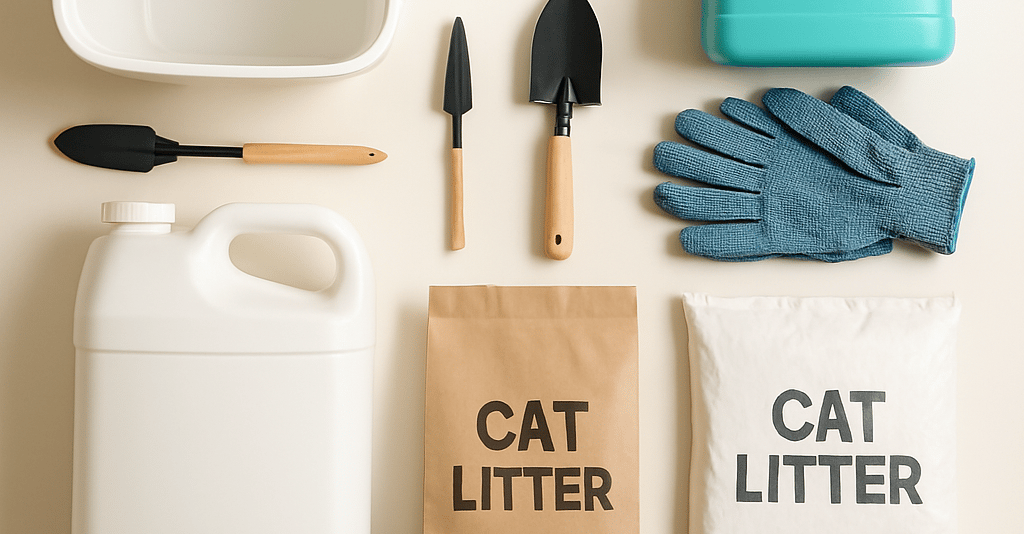Beyond the Scoop: Creative Ways to Repurpose Old Litter Containers
LITTER BOX CHALLENGES & ECO-SOLUTIONS


As dedicated and environmentally conscious cat parents, we often find ourselves looking for ways to minimize our furry friends' impact on the planet. We choose sustainable foods, eco-friendly toys, and biodegradable litters. But what about the containers that the litter itself comes in? Those sturdy plastic pails, buckets, and even large bags can accumulate, contributing to plastic waste if not handled thoughtfully. The good news is that with a little creativity, these containers can be given a new lease on life, moving beyond the scoop and into a realm of practical and imaginative reuse.
This blog post will explore a variety of DIY ideas to repurpose those old litter containers, helping you reduce plastic waste and add a touch of personalized, eco-friendly functionality to your home and garden. We will focus on practical, achievable projects that transform potential trash into useful treasures.
The Plastic Predicament: Why Repurpose?
Plastic waste is a significant global environmental concern. Many cat litter containers, especially the large pails and buckets, are made from durable plastics like High-Density Polyethylene (HDPE) or Polypropylene (PP). While these plastics are often recyclable (check the number on the bottom and your local recycling guidelines!), the recycling process itself consumes energy and resources. Furthermore, not all areas have robust recycling programs for all types of plastics. Repurposing these containers offers a direct way to:
Reduce Landfill Burden: By finding new uses for them, you prevent these bulky items from ending up in landfills where they can take hundreds of years to decompose.
Conserve Resources: Repurposing reduces the need to purchase new items that these containers can effectively replace, thereby saving the raw materials and energy that would have gone into manufacturing those new products.
Decrease Plastic Production Demand: While a small individual step, collective efforts to reuse plastics can contribute to a broader shift in consumer demand and manufacturing practices.
Foster Creativity and Practical Skills: Engaging in DIY repurposing projects can be a fun and rewarding way to learn new skills and create unique items tailored to your needs.
Before you begin any repurposing project, ensure the litter containers are thoroughly cleaned and dried. Remove any remaining litter residue, wash with soap and water, and rinse well. For stubborn odors, a soak with a solution of water and vinegar or baking soda can be effective. Always ensure the container is completely dry before starting your project, especially if you plan to store items sensitive to moisture.
DIY Ideas for Repurposing Litter Pails and Buckets
Those sturdy plastic pails and buckets are incredibly versatile. Here are some creative ways to give them a second life:
1. Garden Helpers
Tool Caddy: Keep your hand trowels, cultivators, gloves, and seed packets organized and portable. You can even drill small holes in the bottom for drainage if you accidentally leave it out in the rain.
Weeding Bucket: A perfect, lightweight container to carry around the garden as you pull weeds.
Harvest Basket: Ideal for collecting fruits, vegetables, or cut flowers from your garden.
Planters: With a few drainage holes drilled in the bottom, litter pails make excellent planters for flowers, herbs, or even small vegetables. You can paint the outside to match your garden decor or leave them as is. For a more decorative touch, consider wrapping them in burlap or fabric.
Watering Can (with modification): Drill small holes in the lid to create a makeshift watering can for gentle watering of seedlings or delicate plants.
Compost Pail: Use a smaller pail with a lid to collect kitchen scraps for your compost bin. The handle makes it easy to carry.
2. Storage Solutions Around the House
Pet Food Storage: If the container is food-grade (check the plastic type and ensure it’s thoroughly cleaned and was not used for clumping litters with silica dust or strong chemical fragrances), it can be used to store dry pet food, keeping it fresh and safe from pests. Ensure the lid seals tightly.
Toy Bin: Perfect for storing your cat’s toys, dog toys, or even children’s smaller toys. They are durable and easy for kids (and pets!) to access.
Cleaning Supplies Organizer: Keep your sponges, brushes, spray bottles, and cleaning cloths neatly stored under the sink or in a utility closet.
Garage and Shed Organizer: Use them to sort and store nails, screws, small tools, car washing supplies, or gardening amendments like bone meal or perlite.
Craft Supplies Storage: Ideal for yarn, fabric scraps, paint tubes, brushes, or other crafting materials.
3. Practical Household Uses
Emergency Kit Container: Store emergency supplies like flashlights, batteries, a first-aid kit, and non-perishable snacks.
Recycling Bin Sorter: Use multiple pails to sort different types of recyclables (paper, plastic, glass) before taking them to the main bin.
Paint Pail: When embarking on a painting project, a clean litter pail is a great substitute for a store-bought paint pail, especially for mixing or carrying smaller amounts of paint.
Utility Bucket: For mopping floors, carrying water for cleaning tasks, or any general-purpose bucket needs.
Creative Uses for Litter Bags
While perhaps less versatile than pails, the large, often sturdy plastic bags that some litters come in can also be repurposed:
Waste Bin Liners: Use them to line smaller waste bins around the house or in the car.
Protecting Plants from Frost: Larger bags can be carefully placed over tender plants during a light frost (ensure there's some airflow).
Drop Cloths for Small Projects: Cut them open to create a small, waterproof surface for messy crafts or minor DIY tasks.
Storage for Bulky, Soft Items: Store out-of-season clothes (if clean and the bags are not scented), extra blankets, or stuffed animals, provided the bags are clean and free of litter dust.
Packing Material: Crumpled bags can be used as void fill when packing boxes for moving or shipping, though ensure they are clean and won't transfer any scent.
Adding a Personal Touch: Decorating Your Repurposed Containers
Don't be afraid to get creative and make your repurposed containers visually appealing!
Paint: Use plastic-compatible spray paints or acrylic paints to change the color or add designs.
Fabric or Burlap: Wrap containers in fabric, burlap, or even old clothes for a softer, more decorative look. Use strong adhesive or a hot glue gun.
Decoupage: Apply paper cutouts or fabric pieces with decoupage glue.
Rope or Twine: Wrap rope or twine around the container for a rustic or nautical theme.
Labels: Clearly label your repurposed containers so you know what’s inside, especially if used for storage.
A Note on Safety and Suitability
Cleanliness is Key: Always thoroughly clean containers before repurposing, especially if they will be used for storing food items (for pets or otherwise, though human food storage is generally not recommended unless the plastic is certified food-grade and new), or items that will be handled frequently by children.
Avoid for Food Gardens (Generally): While pails can be used as planters, it's generally best to avoid using repurposed litter containers (which may have held litters with fragrances or deodorizers) for growing edible plants, just to be on the safe side. Stick to ornamental plants.
Consider the Original Contents: If the litter contained strong fragrances, silica dust, or chemical additives, be more cautious about repurposing the container for items that might absorb odors or where dust residue could be an issue (e.g., fabric storage, children's toys).
Conclusion: Think Outside the Litter Box!
Repurposing old cat litter containers is a fantastic way to reduce waste, save money, and unleash your creativity. From practical garden solutions to organized home storage, the possibilities are numerous. By thinking beyond the scoop, you can make a tangible contribution to a more sustainable lifestyle, one litter container at a time. So, the next time you empty a pail or bag of litter, take a moment to consider its potential before consigning it to the recycling bin or, worse, the landfill. Your planet, and perhaps your decluttered home, will thank you for it.
The EcoCatCare Perspective:
At EcoCatCare, we believe that every aspect of pet parenting can be approached with sustainability in mind. Reducing waste is a cornerstone of eco-friendly living. While choosing biodegradable litters is a great start, thinking about the lifecycle of the packaging is the next step.
Want to learn more about minimizing your environmental pawprint in every aspect of litter management, from choosing the best eco-litter to smart disposal and waste reduction? Our comprehensive Litter Box Transformation Guide touches on all these important topics!
(Disclaimer: Always ensure containers are thoroughly cleaned before repurposing. If you have concerns about the safety of a particular plastic for a specific use, it is best to err on the side of caution or seek alternative containers.)
Sustainable Cat Care
At EcoCatCare, we provide resources that help cat parents discover how sustainable choices can create healthier, happier lives for their feline companions while contributing to a healthier planet.
EcoCatCare © 2025. All rights reserved
